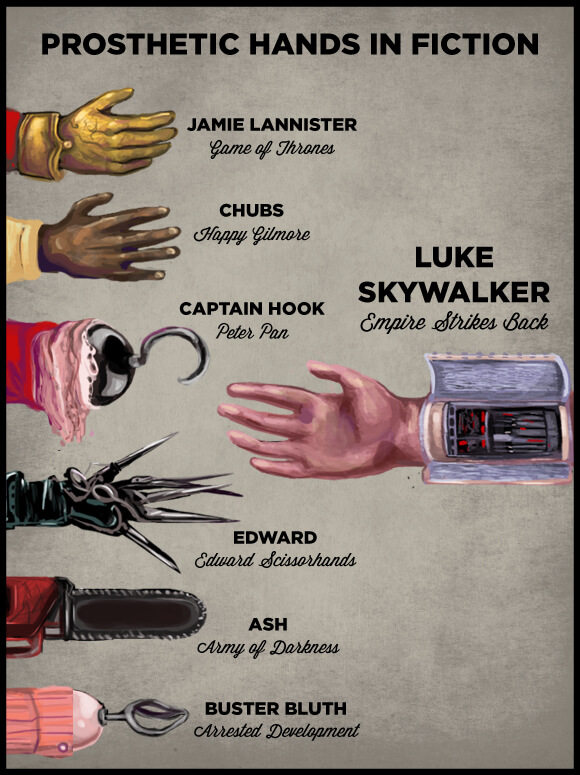When Will We Have Luke Skywalker’s Prosthetic Hand?
The human brain has 86 billion neurons. These individual cells act in concert to send electrical messages that result in our thoughts, memories and movements. No single neuron “knows” what it’s doing. Rather, neurons exhibit emergent intelligence, similar to millions of ants working together to construct and maintain a complex colony.
With this level of complexity, is it possible to program a nervous system from scratch?
In the USC Viterbi Department of Biomedical Engineering, Professor Francisco Valero-Cuevas, along with students Minos Niu, John Rocamora, Victor Barradas and Emily Lawrence, are collaborating with Professors Terry Sanger and Jerry Loeb to build “brain on a chip” models of the nervous system, in which computer programs simulate populations of neurons in the human spinal cord. When running, the encoded neurons could control a robotic or prosthetic hand the same way we control our own bodies. This will be a practical test of our understanding of how complex function emerges in the nervous system from populations of relatively “simple” individual neurons, how they communicate with each other and ultimately how they control our muscles.
“Over a century of trying to develop something that’s better than the split-hook prosthesis, we now have modern robotic hands and prosthetic hands that are amazing grippers, but they’re not dexterous manipulators,” Valero-Cuevas said. “They’re great at holding things, but is it the Luke Skywalker hand that would be able to pick something up, reorient and operate it? Think of all the operations that are needed to use your smartphone with one hand.
“If we really understand fundamental aspects of the nervous system,” Valero-Cuevas continued, “shouldn’t we be able to reproduce fundamental functions like finger motions?”
His projects, funded by the National Institutes of Health, are tackling some of the National Academy of Engineering Grand Challenges about how our brains fundamentally control our bodies. Enhancing our understanding of how the nervous system works will at the same time shed light on how it breaks down and diseases emerge.
And this understanding will directly inform therapeutic interventions for neurological conditions as well as the designs for better, more functional and capable robots. “This work is a true interface between biology and engineering,” Valero-Cuevas said.

Translating a biological system like the spinal cord to computer code is no small feat, but all the information, complexity and beauty of a system like our brain traces back to mathematics.
“It turns out that we agree with something that Galileo said centuries ago: that nature is an open book if you only know the language in which it’s written, and the language is math,” said Valero-Cuevas.
To test his computer models of neural control, Valero-Cuevas is using a very faithful physical system: cadaver hands. Hand surgeons help him connect the hands’ tendons to strings driven by electric motors. The neuron software controls the activity of the motors, as if the motors were muscles themselves. This way, the simulated neurons face the same problem the nervous system faces: controlling the hand as if it were a marionette, driven by complex muscles and tendons. Each finger tendon is controlled by between six and 10 muscles, and in turn, each simulated muscle is controlled by a population of 256 independent neurons.
The goal is for the software and hardware to work in concert to control the cadaver hand the same way a healthy person can move his or her hand, complete with stretch reflexes, muscle tone and compliance.
“We are studying the very fundamental mechanisms of how muscles have tone and how you modify that to get function, and how their disruptions lead to the pathological characteristics of hypertonia, spasticity and dystonia, which are very common in cerebral palsy, stroke and spinal cord injury,” Valero-Cuevas explained. “But we don’t really know where they come from, and we’re trying to understand that. And a team that includes Sanger and Loeb” — both of the USC Viterbi Medical Device Development Facility — “is very powerful in this regard.
“The irony is not lost on us that we’re combining one of the oldest scientific disciplines, hand anatomy, with some of the newest elements of ultra-fast parallel computing. We’re using this to answer central questions about evolution, health and disease, and how all these systems work,” Valero-Cuevas added.
Better prosthetic hands are just one potential application for this wide-ranging work. Another is a robot that is more compliant, meaning that its nervous systems will sense an obstacle and soften when contact is made. This would make robot-human interaction safer, especially for large, strong robots, so an accidental encounter could be more like bumping into a person than colliding with a brick wall.
For Valero-Cuevas, this is just one way that his lab explores the interaction of the brain and body, which is why his research group is called the Brain-Body Dynamics Lab. “Some people think I only work on hands,” said Valero-Cuevas, “but that’s just because hands are an example of a complex system I can have on my desktop.”
Embracing the ideals of Engineering+, Valero-Cuevas is also asking fundamental questions about evolutionary biology, such as why vertebrates appear to have “too many” muscles, what the evolutionary pressures were that led to the specialized body and brain in humans, and how the structure and function of the human nervous system defines the nature of dysfunction and rehabilitation.
“I’m very excited because it will be begin to narrow and define the conversations we should be having have about what is function, what is health, what is disease and what a robot should be like,” said Valero-Cuevas, “and then open up new questions.”



